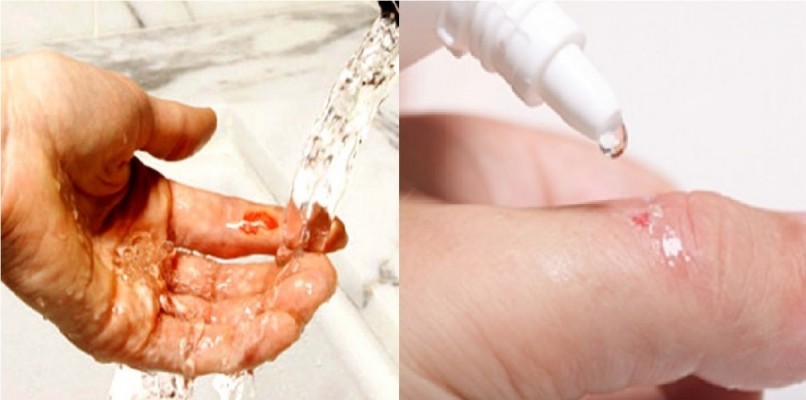Hydrogen Peroxide or soap and water are the most common to be used to clean wound, but what really is the best to use? Check out the article we found at Articles Mercola.
Getting cuts and scrapes are common, both inside and outside your home. These openings in your skin create an opportunity for bacterial growth and infections. Initial cleaning of your wound will help to flush out unwanted bacteria and create an environment to help the open area heal.
Most people either reach for the soap and water or hydrogen peroxide to clean the area before bandaging it. You’ll want to use the most effective cleaner without disturbing the tissue to encourage restoration of the area. One of these materials is definitely better to use than the other.
Why Hydrogen Peroxide Is an Excellent Option
Hydrogen peroxide has been used since the 1920s as an antiseptic because it is effective at killing bacteria. An antiseptic is a substance that prevents the growth of disease-causing microorganisms, such as bacteria.
When you had a cut or scrape as a child, your mother probably reached for the brown bottle of hydrogen peroxide.
When she dabbed it on your cut, you may remember it hurt. That pain or discomfort was a result of the peroxide activating pain receptors in your cut or scrape as it killed the bacteria in the area. It is far safer and more effective than rubbing (isopropyl) alcohol than is commonly used and less staining than iodine.1
Your Wound Needs Oxygen to Heal
Wound healing is a normal process your body initiates whether the wound is a paper cut or a large incision following surgery. In all cases your cuts, scrapes and wounds will heal faster, better and with less scarring when there is plenty of oxygen available.
The chemical composition of hydrogen peroxide is H2O2, containing one more oxygen molecule than water whose composition is H2O. When hydrogen peroxide is put on a cut or scrape, you’ll notice bubbling from the area as the hydrogen peroxide releases one oxygen molecule and becomes water.
How Hydrogen Peroxide Kills Bacteria
Hydrogen peroxide works against bacteria, breaking the cell membranes open by attracting electrons. Inside the bacteria is an enzyme called catalase, causing the fizzing you see when the hydrogen peroxide reacts with the enzyme and releases one oxygen molecule.
Hydrogen peroxide is a very good antiseptic but it isn’t able to distinguish between your healthy cells and those of the bacteria in your wound. The peroxide will attract electrons from your healthy cell membranes, killing them, and react with the catalase in your cells, producing the same fizzing.
Low concentrations of hydrogen peroxide are actually produced by your body after metabolizing sugar or carbohydrates, promoting wound healing.
Your cells have catalase to inactivate the hydrogen peroxide produced inside the cells, but are powerless against the hydrogen peroxide you add to your cut from the outside.
Excessive oxidative damage to your cells from external hydrogen peroxide will slow wound healing and increase your risk of scar formation. Your cells use catalase to inactivate hydrogen peroxide produced by your body to oxygen and water after insulin metabolizes sugar inside the cells.
This link between insulin, metabolized sugar, oxygenation and hydrogen peroxide produced by your body may be one reason why individuals who have insulin-resistant diabetes heal more slowly.
Most clinicians today do not recommend using antiseptic solutions of any kind to clean a cut or wound for the same reason hydrogen peroxide is not recommended. The antiseptic will often destroy your healthy cells, slow healing and increase your risk of scar tissue formation.
However if you do need a powerful and effective antiseptic peroxide is my first choice as it is far safer than rubbing (isopropyl) alcohol. I always travel with a spray bottle of peroxide as it is also useful for cleaning stains from clothes, especially when used in conjunction with soap.
The Truth About Antibacterial Soap
Although the first patent for antibacterial soap was filed in 1984 by David Poshi and Peter Divone, it was Dial bar soap that first made the claim in the 1940s. Dial didn’t put “antibacterial” in their advertising, but advertised their soap as a way to get your body “super clean” by killing bacteria and germs.
Dial used a chemical, hexachlorophene, an antibacterial agent now proven to cause brain damage in infants. In 1970, the company was ordered to remove the chemical from their soap.
Once Poshi and Divone tested their chemical, triclosan, against bacteria and received the patent, Dial was the first to add it to their products claiming it “killed germs on contact.”
Today, antibacterial soaps contain the chemical triclosan, despite the mountains of research demonstrating negative health concerns it triggers.
Antibacterial soap companies have mounted huge advertising campaigns, claiming the soaps would make your environment safer and provide an extra layer of protection against illness.
In December 2013, after 40 years of study, the U.S. Food and Drug Administration (FDA) announced they would revisit the safety of triclosan, citing studies suggesting it can interfere with hormone levels in laboratory animals and increase the growth of drug-resistant bacteria.
The concern voiced by the FDA that antibacterial soap would increase drug resistance in bacteria was made on December 16, 2013. Another statement, published just three days earlier by Colleen Rogers, Ph.D., lead microbiologist at the FDA, indicated antibacterial soaps were not effective against bacteria:
“In fact, there currently is no evidence that over-the-counter (OTC) antibacterial soap products are any more effective at preventing illness than washing with plain soap and water.”
In either case, a decision by the FDA is expected to be released in September 2016 after a lawsuit was brought by the Natural Resources Defense Council (NRDC), in response to decades of delays by the FDA in ruling for or against triclosan and other antibacterial substances.
How to Properly Wash Wounds
The best way to cleanse a cut, scrape or wound is with a safe, mild soap and plenty of water. Choose a soap without triclosan, triclocarban or fragrance.Before washing your cut, wash your hands. This helps reduce the potential for transferring bacteria from your hand to your wound.
Mild to moderate bleeding can occur while you’re cleaning the wound. After cleaning, use direct pressure to stop the bleeding and elevate the area above the level of your heart if you’re able. This helps to reduce the amount of blood to the area to help stop the bleeding.
Rinse your wound with water for five to 10 minutes. This helps to remove dirt and debris from the area. Cool water may feel better to you than warm water, but either is acceptable to use. If you have a sprayer on your kitchen sink, you can try using it to help clean the wound out.
After rinsing thoroughly for five to 10 minutes to remove dirt and debris, use a mild soap with a clean washcloth or piece of gauze to wash the area. Use mild pressure. Hard scrubbing can disrupt the area and prolong healing time without any added benefit to cleansing the area. Cover the area to keep it moist and clean. Wounds that are kept moist and don’t scab will heal better and are less likely to scar.
Why Silver Should be in Your Medicine Cabinet
The antimicrobial properties of silver have been known since 400 B.C., and silver was commonly used as an antimicrobial agent in wound management until the early 20th century. Modern science has since confirmed silver’s antimicrobial effects. It’s even been shown to be effective against antibiotic-resistant bacteria.
Tests reveal that silver destabilizes the structure of the bacterial cell membrane, making it more porous, which allows the silver to enter the bacteria and kill it from the inside.
Silver-containing hydrofiber dressing has been shown to offer effective protection against proliferation of a broad range of aerobic, anaerobic and antibiotic-resistant microorganisms in wounds. Silver nanoparticles incorporated into a thermosensitive gel has also been tested and found to be effective against Staphylococcus aureus.
A 2010 study also found colloidal silver effectively killed drug-resistant staph, E.coli, Salmonella, and Pseudomonas aeruginosa, the latter of which typically occurs in hospitals and in people with weakened immune systems. Considering the risk of contracting a drug-resistant infection from a cut or scrape, it seems reasonable to conclude that keeping a bottle of high quality silver in your medicine cabinet would be a prudent strategy, and to use it any time you get a cut, scrape or other topical wound.
Next Article: Stop Wounds Bleeding In 10 Seconds
Read Full Article: Hydrogen Peroxide or Soap and Water to Clean Your Wound?







Jessica Triplett Hamilton
Aug 24. 2016
Richard Smith
Natural Healing Zone
Aug 24. 2016
thanks for that!
Natural Healing Zone
Aug 24. 2016
anyone love this post as much as i do
TCM Healing Secrets
Aug 25. 2016
I agree Sweet comment thanks so much
TCM Healing Secrets
Aug 25. 2016
Thanks big this topic fan here
TCM Healing Secrets
Oct 16. 2016
love the fanpage
Let Them Eat Cake
Oct 16. 2016
Yup Indeed
Let Them Eat Cake
Oct 16. 2016
Absolutely adore everything about
People Regaining Their Health Pics
Jan 31. 2017
Anything related to great health is very important